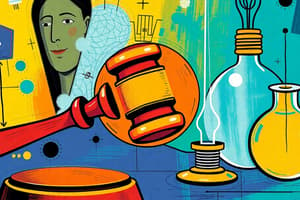Podcast
Questions and Answers
What are the three main requirements for an invention to be patentable?
What are the three main requirements for an invention to be patentable?
Be new, involve an inventive step, be capable of industrial application
Define the requirement of 'newness' for an invention to be patentable.
Define the requirement of 'newness' for an invention to be patentable.
The invention must never have been made public before the patent application date.
Explain what 'inventive step' means in the context of patentability.
Explain what 'inventive step' means in the context of patentability.
The invention must not be obvious to someone with good knowledge and experience in the subject.
What is meant by 'industrial application' in the context of patentable inventions?
What is meant by 'industrial application' in the context of patentable inventions?
Give an example of what an invention could be, based on the requirements for patentability.
Give an example of what an invention could be, based on the requirements for patentability.
What is the main purpose of Intellectual Property Rights (IPR)?
What is the main purpose of Intellectual Property Rights (IPR)?
How does Intellectual Property differ from tangible assets?
How does Intellectual Property differ from tangible assets?
What can the owner of Intellectual Property Rights do if someone infringes on their rights?
What can the owner of Intellectual Property Rights do if someone infringes on their rights?
How does the World Trade Organization (WTO) define Intellectual Property Rights?
How does the World Trade Organization (WTO) define Intellectual Property Rights?
Why is Intellectual Property considered an asset?
Why is Intellectual Property considered an asset?
What is the significance of Intellectual Property compared to physical assets for a company?
What is the significance of Intellectual Property compared to physical assets for a company?
Intellectual property (IP) is the product of the human intellect including inventions, industrial models, trademarks, songs, literature, symbols, names, brands, etc. Intellectual Property Rights (IPR) are mostly the same as ______ rights.
Intellectual property (IP) is the product of the human intellect including inventions, industrial models, trademarks, songs, literature, symbols, names, brands, etc. Intellectual Property Rights (IPR) are mostly the same as ______ rights.
IPR also prevent others from using, dealing or tampering with their product without prior permission from them. In fact, the owner of the IPR can legally sue someone else for ______ and force them to stop and compensate for any damages.
IPR also prevent others from using, dealing or tampering with their product without prior permission from them. In fact, the owner of the IPR can legally sue someone else for ______ and force them to stop and compensate for any damages.
Intellectual property is a broad category description for the set of intangible assets owned by a company or individual. An intangible asset is a non-physical asset that a company or person owns. Like tangible assets (physical property like buildings, equipment, etc.) it can be protected by laws to stop others from copying, using or accessing without ______.
Intellectual property is a broad category description for the set of intangible assets owned by a company or individual. An intangible asset is a non-physical asset that a company or person owns. Like tangible assets (physical property like buildings, equipment, etc.) it can be protected by laws to stop others from copying, using or accessing without ______.
Although it's an intangible asset, intellectual property can be far more valuable than a company's ______ assets.
Although it's an intangible asset, intellectual property can be far more valuable than a company's ______ assets.
Intellectual property rights are the rights given to persons over the creations of their minds. They usually give the creator an exclusive right over the use of his/her creation for a certain period of ______.
Intellectual property rights are the rights given to persons over the creations of their minds. They usually give the creator an exclusive right over the use of his/her creation for a certain period of ______.
Intellectual property is an ______.
Intellectual property is an ______.
Flashcards are hidden until you start studying




